The maize plant belongs to the Poaceae family of grasses. Among cereals, maize has the highest genetic yield potential, which makes it known as the queen of cereals. The crop is cultivated in 160 countries with diverse soils, climates, biodiversity, and management practices, contributing 36 % to global grain production. From loamy sand to clay loam, maize can be grown successfully in various soil types. There are nodes and internodes on the stem of the maize plant. Per plant, 8 to 21 large leaves extend from each internode.
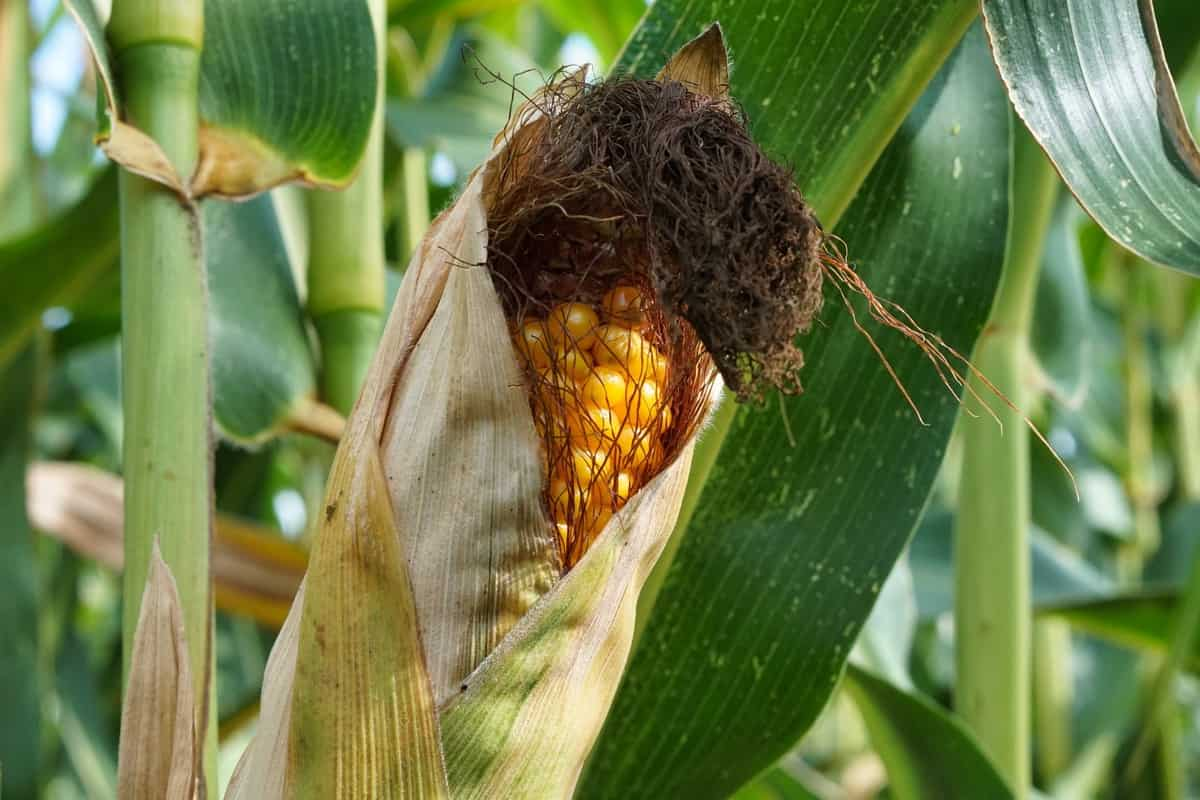
The leaves are linear or lanceolate from 30 to 100 cm in length with an obvious midrib. The grains of maize, or kernels, are encapsulated in husks and number 30 to 1000 per ear. The kernels come in various colors, including white, yellow, red, purple, or black. Plants such as maize survive only one growing season and reach heights of 2 to 3 meters. Consequently, the maize crop is susceptible to various pests and diseases described below.
Pest and disease management in Maize
Maize insect pests
Corn Leaf Aphid
Corn leaf aphids commonly attack maize, barley, millet, broomcorn, sorghums, Sudan grass, and many other wild and cultivated grasses. Infestations of this aphid on wheat, oats, and rye are rare, although they have been reported to attack these crops.
Identification
Adults of the wingless corn leaf aphid, Rhopalosiphum maidis, are oval and about 2.0 mm long. It is usually green to blueish-green with black antennae, legs, cornicles, and a dark area at the base. A row of black spots can be seen on each side of the abdomen, and two longitudinal dark bands on the head. Often, the body appears powdery.
Damage symptoms
- The corn leaf aphid injures maize by the removal of plant sap and the introduction of diseases. In addition, feeding by colonies of this aphid causes mottling and discoloration of the leaves.
- Both adults and nymphs consume sap and produce honeydew. A fungus known as sooty mold grows on honeydew, inhibiting photosynthesis and reducing grain development.
- In addition, these aphids transmit a disease called mosaic.
- Plants with high numbers can turn yellow and appear unthrifty. A water-stressed plant may experience yield loss.
Biological Control
Corn leaf aphid populations are subject to control by many different natural enemy species, including parasitic wasps and predators such as syrphid fly larvae. This biological control is fostered by avoiding insecticide applications unless necessary.
Chemical control
- Apply any of the following granular insecticides on the 20th day of sowing, mixed with 50 kg of sand
- Phorate 10% CG at 10 kg/ha
- Carbaryl 4% G at 20 kg/ha.
- The following insecticides can be used if granular insecticides are not used
- On the 20th day of sowing, spray Carbaryl 50 WP at 1 kg/ha (500 liters of spray fluid per hectare).
- At 660 ml per hectare, dimethoate 30% EC can be applied
In case you missed it: Best Fertilizer for Maize: Organic, NPK, Compost Manure, and Schedule
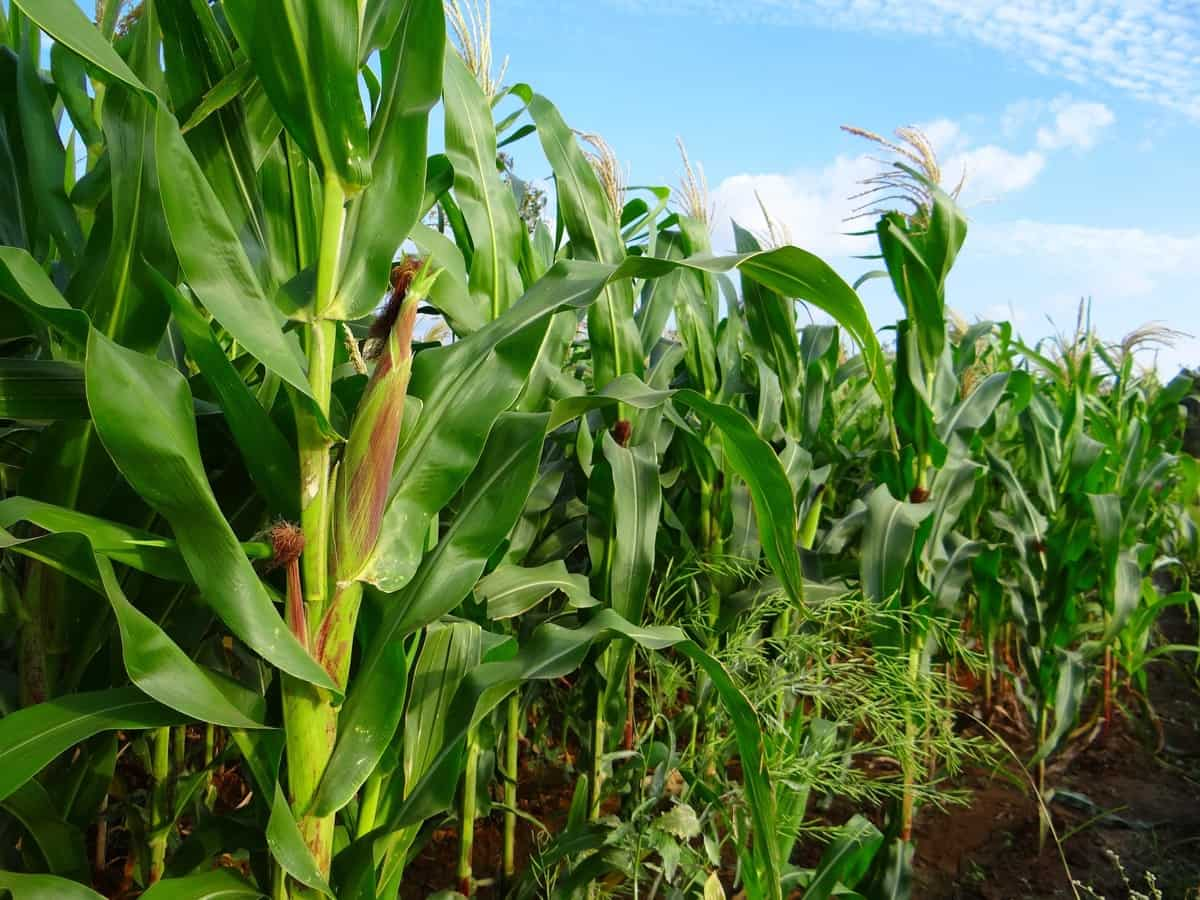
Fall Armyworm
The Fall Armyworm is an insect pest that damages more than 80 plant species, including maize, rice, sorghum, vegetable crops, and cotton. Originally from tropical and subtropical America, it is now found worldwide.
Identification
The female moths lay egg masses on the upper or underside of the leaf and are covered with tan-colored scales. The incubation period varies from 4-5 days. Smooth-skinned larvae vary in color from light tan or green to light gray, with a yellow dorsal and lateral pattern.
The larva contains a reddish brown head with a predominantly white, inverted Y-shaped suture between the eyes. Reddish brown is the color of the pupa. Adults emerge from pupae after 7-9 days. In male moths, the forewings are marked with fawn spots, and the apical margin is white, while in female moths, the pattern is less distinct, from gray to finely mottled gray.
Damage symptoms
- Fall Armyworm attacks maize crops at all stages, from seedling emergence to ear development. Papery spots caused by silvery transparent membranes are caused by FAW larvae scraping and skeletonizing the upper epidermis of whorl leaves.
- There are also pinhole symptoms on the leaves due to the damage. It is because the older larvae remain inside the whorl and feed there.
- Due to the damage caused by late instars (4th instar and onwards), leaves are extensively defoliated, and there is an abundance of fecal pellets in whorls.
- Kernels may be eaten away by this insect. While FAW causes significant yield losses, ear feeding reduces quality and yield.
Biological control
- Release egg Parasitoid such as Trichogramma pretiosum, Telenomus remus
- Release Egg-larval Parasitoid like Chelonus sp and larval parasitoids like Coccygidiumsp and Campoletis chlorideae to control these worms
- And also, predatory pentatomid bugs, earwigs play a major role in controlling adult worms
Chemical control and management
- Wherever possible, add 200kg/acre of neem cake to fields where maize is grown without tillage
- Maintain field bunds clean and plant flowering plants such as marigolds, sesame, niger, sunflowers, coriander, fennel, etc., to attract natural enemies.
- Treatment of seeds with Cyantraniliprole 19.8% + Thiamethoxam 19.8% FS at 6 ml/kg protects for 15-20 days.
- If infestation is more than 10%, whorl applies any of the below-recommended insecticides for FAW.
Chemical compound | Dosage/acre | Dosage/liter water |
| Chlorantraniliprole 18.5 SC | 80 ml | 0.4 ml |
| Thiamethoxam 12.6 % + Lambda-cyhalothrin 9.5% ZC | 50 ml | 0.25 ml |
| Spinetoram 11.7 % SC | 100 ml | 0.5 ml |
| Emamectin benzoate5% SG | 80 grams | 0.4 grams |
In case you missed it: Simple Techniques to Increase the Maize Yield for Higher Profits
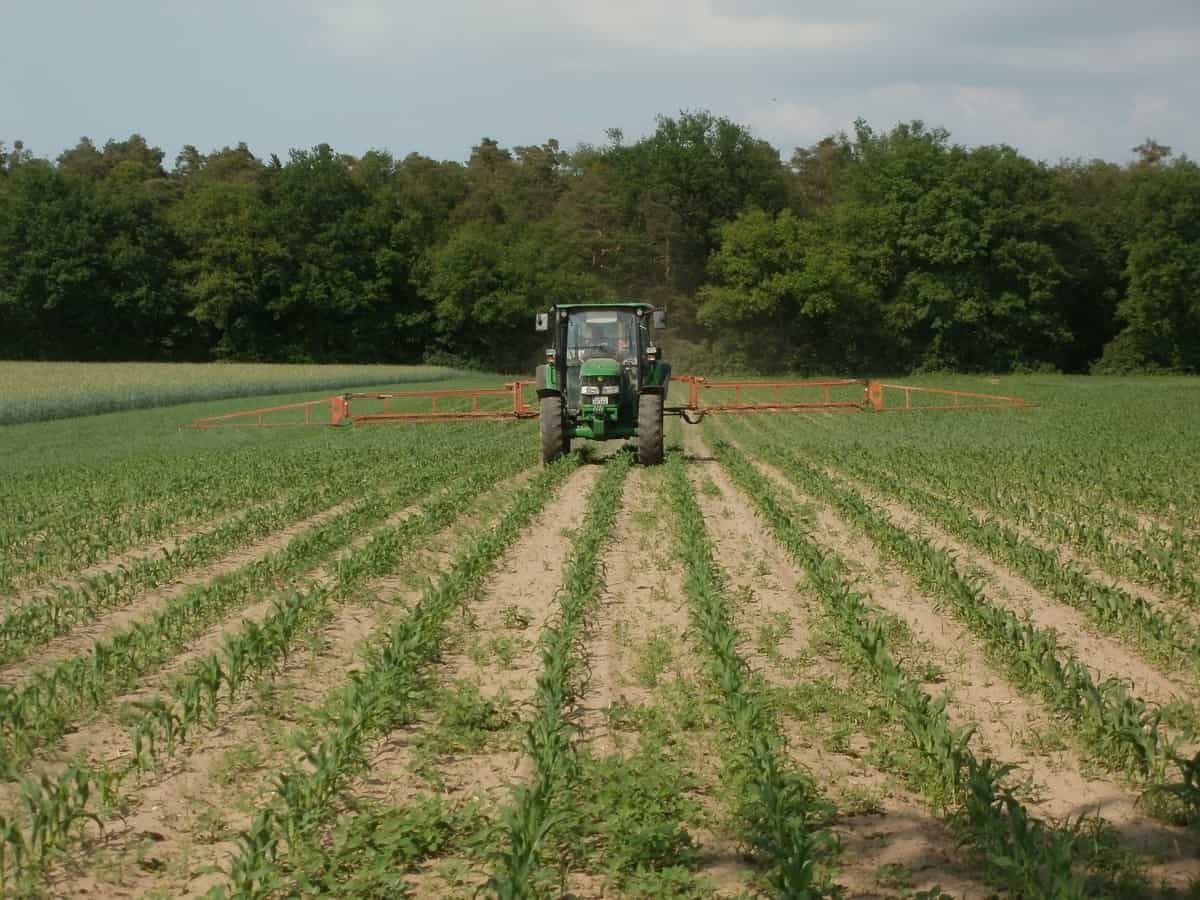
Shoot fly
It usually attacks the maize crop at an early stage. Due to this, the infested plants remain stunted with many tillers. After hatching, its larvae enter the central shoots. Consequently, the central shoot wilts and finally becomes yellowish, which gives rise to dead hearts, while lateral leaves remain green. Its infestation occurs at the early stage, i.e., after mid of July, and reaches maximum infestation level in the first week of August.
Identification
Its eggs are elongated like small rice grains, milky white with two wing-like projections, and cylindrical with fine surface ridges. Incubation lasts 1-3 days, and the larval stage lasts 7-10 days with 3-4 instars. The full-grown larva is yellow. The adult lives for 3-4 days. The life cycle is completed in about three weeks.
Damage symptoms
- Maize is infested from 2 days to 3 weeks after emergence by these adults that oviposit on the abaxial surface of basal leaves, shoots, and soil near the plant’s base.
- As larvae feed, they bore into the shoot and gradually kill the growing point, resulting in the death of the central shoot, referred to as the dead heart, which forms within two weeks of germination.
Biological control
- Predators like Coccinellids, spiders, robber flies, pentatomid bugs, and earwigs play a major role in controlling these shoot flies.
- Removal and destruction of dead hearts
Chemical control and management
- Seed treatment with Imidacloprid at 6ml/kg of seeds provides good control of the shoot fly.
- Early sowing during the first fortnight of February avoids the build-up of shoot fly population and Soil application of phorate 10%CG 10 kg/ha at the time of sowing
Spider Mites
Spider mites are tiny microscopic arthropods. They differ from insects in having eight rather than six legs in the adult stage. Spider mites usually overwinter as fertilized females resistant to low temperatures. In mild winters, they may continue to feed and lay eggs. In summer, many generations develop.
Identification
These females are red instead of the active summer forms, which are yellowish-green. The number of eggs laid is dependent on the temperature. The female produces about 100 eggs over a few days in warm weather, producing up to 19 eggs a day. Eggs hatch into six-legged larvae that next develop into eight-legged nymphs. There are two nymphal stages. After the larval and each nymphal stage, a resting stage occurs.
Damage symptoms
- All active stages of spider mites damage maize by piercing plant cells of the leaf with their mouthparts and sucking the juices.
- Feeding causes premature drying, resulting in loss of leaf tissue, stalk breakage, and kernel shrinking.
- Those mites that damage leaves above or at the level of the ear have the greatest impact on yield. The upper leaf surface evidence of mite feeding is a yellowish and stippled area where mites are feeding on the lower leaf surface.
- Heavily-infested leaves turn completely pale and dry up. Both the Banks grass mite and the two-spotted spider mite produce webbing on the lower leaf surface in which the various stages of the mites are present.
- Webbing is initiated near the midribs of the host plant and gradually envelopes the plant as the population increases.
Biological controls
- Biological controls are provided by various insects and predatory mites that feed on spider mites. Lady beetles, known as “spider mite destroyers” (Stethorus species), are specialized predators of spider mites.
- Among the most critical natural enemies are minute pirate bugs, big-eyed bugs (Geocoris species), and predatory thrips.
In case you missed it: Organic Maize Farming, Cultivation Practices (Corn)
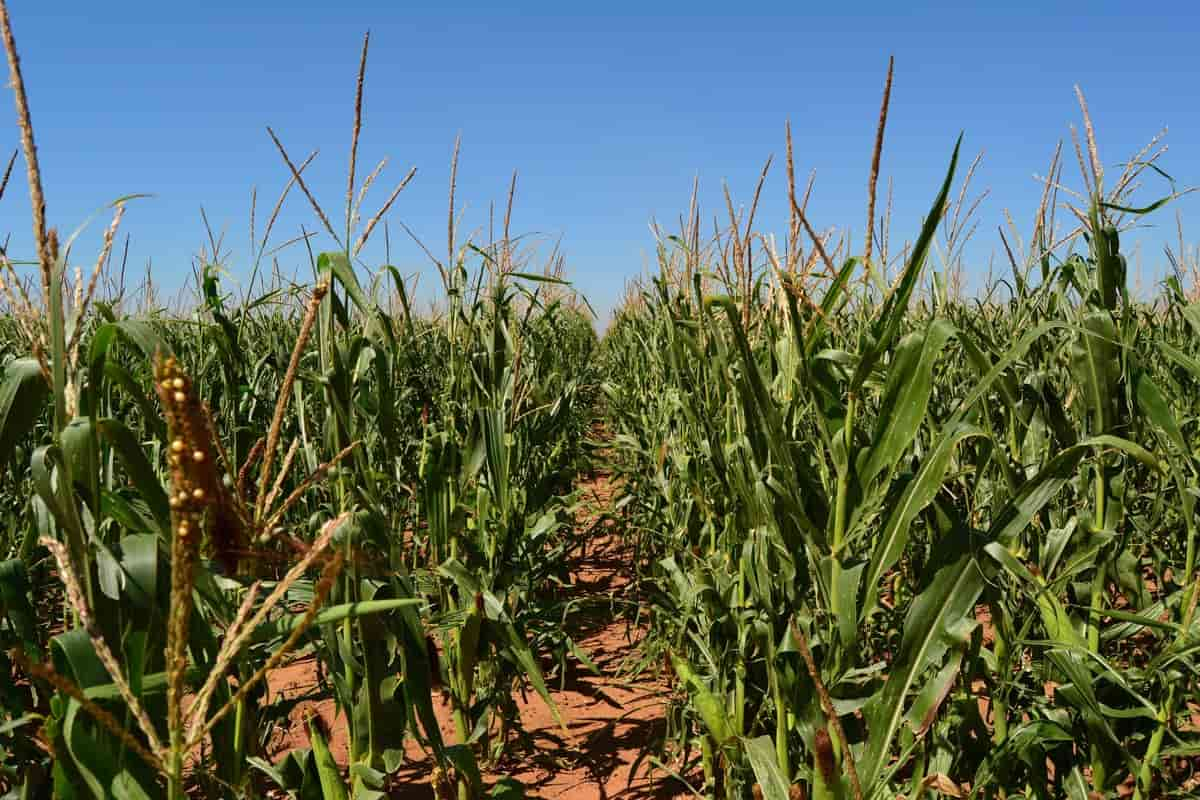
Chemical control
- Spraying of dicofol 18.5 EC at 2 ml per liter or wettable sulfur at 3 grams per liter
- Spray application of chlorfenapyr 10 EC at 500 ml/ha (monthly interval)
- Fluvalinate 25 EC at 50 ml/ha also suppresses these insects.
Thrips
Maize thrips attack seedlings and vegetative growth stages. Thrips in the whorl can stop the growth of small plants. Damage is more severe if plants are stressed by drought or water logging. Inspect weekly during seedling and vegetative stages. Thrips build up on alfalfa, weeds, and other vegetation in spring and then move to maize from these hosts when they are cut or dried up.
Identifications
The western flower thrips adults are very small, about 1 mm long. Wings are narrow and fringed with long hairs. Compared to the male, the female is larger, yellow to dark brown, and has a more rounded abdomen. There is always a pale yellow color on the male and a narrower abdomen on the male. The eggs are yellowish and not visible because they are laid into the plant tissue. The larvae develop through two instars. Second instars become whitish before molting. Both the prepupa and pupa are yellowish, quiescent non-feeding stages.
Damage symptoms
- The most common places where thrips can be found are on whorls, tassels, ears, or under leaves. Their modified left mandible is inserted into the tissue, and they suck the fluids from the cells.
- Thrips are most noticeable and cause severe damage at two maize growth stages, young plants, and ear formation.
- Feeding on young seedlings stunts plants. During a heavy thrips infestation, distorted leaves turn brownish around the edges and cup upward.
Biological control
- Grass and weeds should be removed from around field areas to eliminate these pests.
- Introduce beneficial insects, such as minute pirate bugs, an effective thrips predator (feeds on eggs and larvae before they become adults).
- And also, ladybugs and lacewing (especially effective in greenhouses) attack and destroy all stages of this pest.
Chemical control
- Sprinkle water over the seedlings to check the multiplication of thrips.
- Treat seeds with Imidacloprid 70% WS at 12 g/kg of seed.
- Apply carbofuran 3% G at 33 kg/ha or phorate 10 % G at 10 kg/ha.
Major diseases in maize crop
Common Rust
The disease is caused by the fungus Puccinia sorghi. The spores can be transported over great distances by winds and rain. They start the infection process when landing on the leaves. Secondary infection from plant to plant can also occur due to wind and rain.
In case you missed it: Maize Seed Germination (Corn), Time Period, Procedure
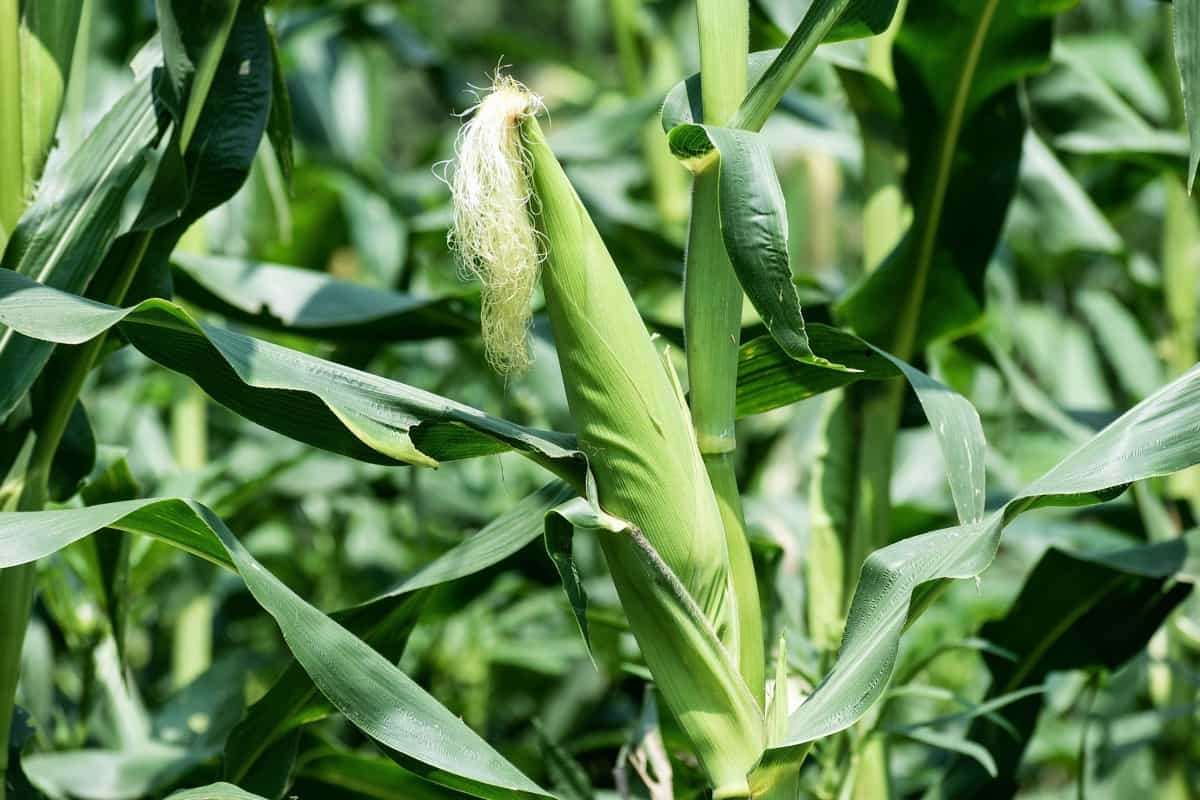
The development of the disease is favored by high relative humidities (nearly 100%), dew, rain, and cool temperatures between 15 and 20°C (may vary depending on area). Hot, dry weather will slow or hinder the development of the fungus and the incidence of the disease. Yield is reduced due to lower plant productivity and lodging.
Damage symptoms
- Circular to elongate golden brown or cinnamon brown, powdery, erumpent pustules appear on both leaf surfaces
- As the crop matures, brownish-black pustules containing dark thick-walled two-celled teliospores develop.
- In severe cases, the infection spreads to sheaths and other plant parts.
Chemical control and management
- Remove the alternate hosts and spray Mancozeb at 2 kg/ha.
- And also, Several protectant fungicides have been recommended, such as chlorothalonil and Mancozeb. Plants are monitored, and sprays commence when there are six pustules per leaf on average.
Downy Mildew
Water mold or fungi like Oomycete organisms cause downy mildew on foliage. Downy mildew is one of the thousands of water molds that exist. Typically, they specialize in a particular species or group of plants. They cause several plant diseases. Airborne spores spread from plant to plant. The disease is associated with wet weather since prolonged leaf wetness favors infection. They can devastate a crop and kill most of the plants in days.
Symptoms
- Chlorotic streaks on leaves are the most characteristic symptom.
- Due to the shortening of internodes, plants appear stunted and bushy. In addition, a white downy growth is covering the lower surface of the leaf.
- Downy growth can also be seen on the bracts of green unopened male flowers.
- The proliferation of auxiliary buds on the stalk of the tassel and the cobs is common
Chemical control and management
- Deep plowing and crop rotation with pulses.
- Treat the seeds with Metalaxyl at 6g per kg and Rogue out infected plants.
- Spray the crop with Metalaxyl + Mancozeb at 1kg on the 20th day after sowing.
- Grow resistant varieties and hybrids viz. CO1, COH1 and COH2.
- The spray of Mancozeb 2.5 g/l
Bacterial Stalk Rot
The discoloration of leaves, leaf sheath and the nodes of the stalk characterizes bacterial stalk rot of maize. The disease then develops rapidly along the stalk and spreads to other leaves. Borer insects play a significant role in the initiation of the disease. The organism is soil-borne and enters through wounds and injuries on the host surface. The organism survives saprophytically on the debris of infected material and serves as the primary inoculum in the next season.
Symptoms
- A soft rot develops on the basal internodes, creating a water-soaked appearance. A sweet fermenting odor accompanies rotting.
- Leaves sometimes show signs of wilting or water loss, and affected plants lodge or topple down within a few days of infection.
- Rot may also be found in ears and shanks. As a result, the ears do not develop further and hang down from the plant.
Chemical control and management
- Always consider an integrated approach of preventive measures and biological treatments if available.
- Chlorination of irrigation water or soil drenching with bleaching powder of 33% chlorine at 10 kg/ha at the pre-flowering stage is recommended.
- Formulations containing copper oxychloride can also be effectively applied against the disease.
- Finally, adding 80 kg/ha of Muriate of potash in two splits reduces the severity of the symptoms.
Charcoal rot
The fungus attacks many crops, including maize, sorghum, pearl millet, finger millet, and pulses. The virus will survive in infected plant debris for more than 16 years. Soil-borne sclerotia are the primary source of infection. However, pathogens also attack other hosts, which aids in their perpetuation.
In case you missed it: Maize Cultivation Income (Corn), Cost, Yield, Profit
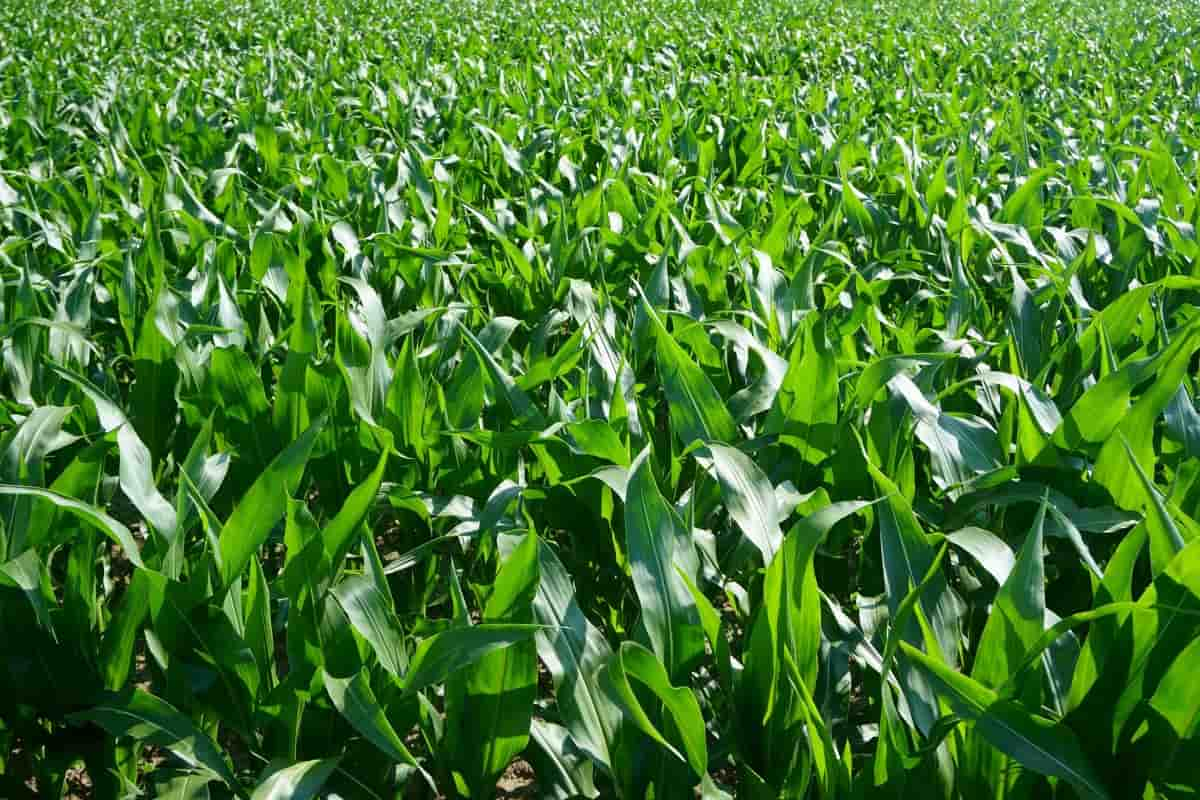
As a facultative parasite, the fungus can live saprophytically on dead organic tissues, particularly on sclerotial bodies produced by its natural hosts. During the susceptible crop stage, the fungus overwinters in the soil, enters the host through the roots, and proceeds toward the stem.
Symptoms
- The affected plants exhibit wilting symptoms.
- A grayish streak can recognize the stalk of the infected plants.
- Sclerotia develop on the vascular bundles, and the pith becomes shredded.
- It is common for stalks to break in the crown area after they are shredded in the interior. Infected plants develop dark crowns.
Chemical control and management
- Avoidance of water and nutrient stress at the flowering time reduced disease incidence
- Apply potash at 80 kg/ha in endemic areas
- Long crop rotation that is not a natural host of the fungus.
- Treat the seeds with Carbendazim or Captan at 2 g/kg.
Turcicum Leaf Blight
The fungus Exserohilum turcicum causes Turcicum leaf blight. A growing season characterized by high humidity and moderate temperatures (17 to 27°C) is a major constraint for maize production in many growing regions worldwide. Turcicum leaf blight has been linked to yield losses of up to 70%. Crops are affected at an early stage by the fungus.
Disease symptoms
- Leaf spots that are oval and water-soaked are the earliest symptoms.
- Cigar-shaped lesions measuring 3 to 15 cm in length are characteristic of mature symptoms.
- Fungal sporulation is associated with elliptical, tan-colored lesions that develop distinct dark areas as they mature.
- As the crop matures, lesions typically appear on lower leaves, spreading to upper leaves and ear sheaths.
- Lesions may coalesce under severe infection, blighting the entire leaf.
Chemical control and management
- Treat the seeds with Captan or Thiram at 4 g/kg.
- Disease control is achieved by applying Maneb or Zineb at 2.5-4.0 gm/liter of water at intervals of 7-10 days.
Conclusion
While maize is a high-yielding crop, farmers must protect the plants’ health throughout the growing season to maximize their yield. At different times during the maize’s life cycle, the pests mentioned above and pathogens can threaten its growth and production. So you should be able to control them to minimize yield losses.
- Economical Aquaculture: A Guide to Low-Budget Fish Farming
- 15 Common Planting Errors That Can Doom Your Fruit Trees
- How to Make Houseplants Bushy: Effective Tips and Ideas
- Innovative Strategies for Boosting Coconut Pollination and Yield
- Pollination Strategies for Maximum Pumpkin Yield
- The Complete Guide to Chicken Fattening: Strategies for Maximum Growth
- Natural Solutions for Tulip Problems: 100% Effective Remedies for Leaf and Bulb-Related Issues
- Revolutionizing Citrus Preservation: Towards a Healthier, Greener Future
- Natural Solutions for Peony Leaf and Flower Problems: 100% Effective Remedies
- Maximizing Profits with Avocado Contract Farming in India: A Comprehensive Guide
- Natural Solutions for Hydrangea Problems: 100% Effective Remedies for Leaf and Flowers
- The Ultimate Guide to Choosing the Perfect Foliage Friend: Bringing Life Indoors
- From Sunlight to Sustainability: 15 Ways to Use Solar Technology in Agriculture
- The Ultimate Guide to Dong Tao Chicken: Exploring from History to Raising
- The Eco-Friendly Makeover: How to Convert Your Unused Swimming Pool into a Fish Pond
- Mastering the Art of Delaware Chicken Farming: Essentials for Healthy Backyard Flocks
- 20 Best Homemade Fertilizers for Money Plant: DIY Recipes and Application Methods
- How to Craft a Comprehensive Free-Range Chicken Farming Business Plan
- Brighten Your Flock: Raising Easter Egger Chickens for Beauty and Bounty
- How to Optimize Your Poultry Egg Farm Business Plan with These Strategies
- Subsidy for Spirulina Cultivation: How Indian Government Schemes Encouraging Spirulina Farmers
- Ultimate Guide to Raising Dominique Chickens: Breeding, Feeding, Egg-Production, and Care
- Mastering the Art of Raising Jersey Giant Chickens: Care, Feeding, and More
- Ultimate Guide to Raising Legbar Chickens: Breeding, Farming Practices, Diet, Egg-Production
- How to Raise Welsummer Chickens: A Comprehensive Guide for Beginners
- How to Protect Indoor Plants in Winter: A Comprehensive Guide
- Ultimate Guide to Grow Bag Gardening: Tips, Tricks, and Planting Ideas for Urban Gardeners
- Guide to Lotus Cultivation: How to Propagate, Plant, Grow, Care, Cost, and Profit
- Agriculture Drone Subsidy Scheme: Government Kisan Subsidy, License, and How to Apply Online
- Ultimate Guide to Raising Araucana Chickens: Breed Profile, Farming Economics, Diet, and Care
- Bringing Hydroponics to Classroom: Importance, Benefits of Learning for School Students
- Ultimate Guide to Raising Polish Chickens: Breed Profile, Farming Economics, Diet, and Care
- Ultimate Guide to Raising Australorp Chickens: Profile, Farming Economics, Egg Production, Diet, and Care
- Silkie Chicken Farming: Raising Practices, Varieties, Egg Production, Diet, and Care
- Sussex Chicken Farming: Raising Practices, Varieties, Egg Production, Diet and Care
- Homemade Feed Formulations for Livestock: Discover Cost-effective Starter to Finisher Feed Recipes